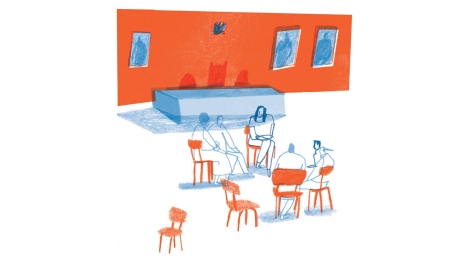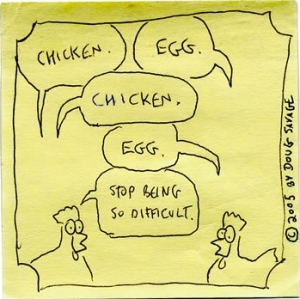
Art by Rachel Gannon
In honour of World Philosophy Day, I’m capping off my series on relativism and evaluativism today. If you haven’t read my previous posts in the series – Epistemology Needs to Matter, Dying Goats and Flying Dogs, Tolerance Gone Rogue, and Friendly Excursions into Disequilibrium – I’d suggest you start with those.
Onwards! I’m proposing three strategies that educators can use to promote genuine dialogic argument. These strategies are ones that I’ve found useful in averting pseudo-arguments –– those superficial, directionless and disjointed conversations among individuals who inter-splice their monologues while remaining essentially deaf to one another.
A friend of mine likens the pseudo-argument pattern of talk to the parallel play of two-year-olds, engrossed side-by-side in their respective imaginary worlds. Let’s see what we can do to make the switch from parallel play to cooperative play in the philosophy classroom.
1) ‘Sympathise, then criticise’
We often talk about students making their individual thinking accountable to a community of their peers. The accountability arises from community members testing one another’s ideas, and it’s a vital aspect of collaborative philosophical enquiry. Individual thinkers rely on each other to elucidate the norms of thinking, to frame problems appropriately, to provide insights from different perspectives, to identify unconscious biases, to challenge one another’s claims and inferences, and to keep each other ‘on track’.
In facilitating enquiry, educators must foster a critical spirit –– but we need to remember that a good critique is always constructive. It should be built on an honest and charitable interpretation of the arguments being considered. So, teachers, here’s what you can do to promote a sympathetic and constructive approach to criticism in your classroom:
- First, determine which student’s position is under scrutiny, and try to re-express that student’s position as clearly, vividly and fairly as you can.
- Second, ask yourself: “How might that student’s argument be revised to meet objections? How might it be strengthened?”
- Third, try to establish common ground among students who hold divergent positions. Highlight any points on which the students agree, and encourage them to use these points of agreement – these shared beliefs – to bolster their respective arguments.
Once you’ve modelled the sympathy, it’s up to your students to do the criticism. Is the argument unclear? Inconsistent? Implausible? Might there be any objections or counter-examples to its claims? Are there false assumptions, or bad inferences? Does an alternative argument better defend the same position? These questions are all good starting points for legitimate criticism.
By helping students to sympathise before they criticise, you properly equip them to do justice to each other’s arguments.
2) Focus on criteria
When two or more students disagree (and each one appears to be coherent and rational), there’s a chance that they’re arguing from radically different axiomatic beliefs –– but in many cases, the disagreement is more tractable. It can often be traced to the use of different implicit criteria for judgement. In some of these instances, controversies can be resolved just by making those various criteria explicit.
To use this strategy effectively, you need to first listen very carefully for the contrasts or tensions between what different students are saying. Then, you can ask questions to clarify exactly which criteria the students are using as a basis for their respective judgements.
A focus on criteria helps you to represent the divergences in students’ judgements in a way that opens up the possibility of re-evaluation. For any given claim that’s been expressed, you can invite students to assess how well it measures up to the community’s shared criteria for judgement (to the extent that agreement on criteria has been reached).
A focus on criteria is elemental to the success of dialogic argument. It not only helps students evaluate claims that have been defended, but it helps them generate agreed standards for evaluating fresh claims that might be made in due course, as the class goes on to explore a broader range of cases or scenarios.
Criteria provide a framework for the comparative evaluation of competing arguments. Without criteria, there can be no reasoned judgement. And without the elucidation of shared criteria, common ground is hard to come by, and flawed arguments are hard to spot –– which brings me to my final strategy.
3) Celebrate changes in thinking
We often ask students to take a stand: to agree or disagree with a proposition. But we don’t want them merely to vote on a given issue. We want them to think about it. We want them, eventually, to reconsider their certainties, to dissolve false dichotomies, to refine their arguments, and to discover nuance and complexity.
Typically, they can’t achieve these things by being staunch.

They need to adapt, to incorporate new insights, perhaps make concessions, moderate their views, or even renounce what they previously believed (if this is warranted by reason and evidence).2
As teachers, we can help by celebrating moments when students thoughtfully concede points or change their minds: in short, moments of self-correction. Celebrating these changes shows students that we value their learning more than we value their winning.
………………………………….
1 Inspired by Robert Frost’s phrase: “Thinking is not to agree or disagree. That’s voting.”
2 It helps for students to be able to think metacognitively (that is, to observe the workings of their own reasoning) –– and for them to understand the nature of reasoning, what constitutes a good reason, and why good reasons ought to move us to belief or action.
………………………………….
Further reading:
Kuhn, D., Hemberger, L. & Khait, V. (2015), Argue With Me: Argument as a Path to Developing Students’ Thinking, 2nd edition. Routledge.
Reznitskaya, A., & Wilkinson, I. A. G. (2017), The Most Reasonable Answer: Helping students build better arguments together. Harvard Education Press.
………………………………….
This is the final post in a five-part series about epistemological understanding, published in the lead-up to World Philosophy Day 2018. You may wish to return to the beginning of the series.
………………………………….
The Philosophy Club works with teachers and students to develop a culture of critical and creative thinking through collaborative enquiry and dialogue.

Hi Michelle, this is an excellent series, thanks very much.
Alan
Thanks for your support, Alan. Kuhn’s epistemological levels material provides such a fruitful framework – I think it’s high time it got the recognition it deserves in P4C circles!